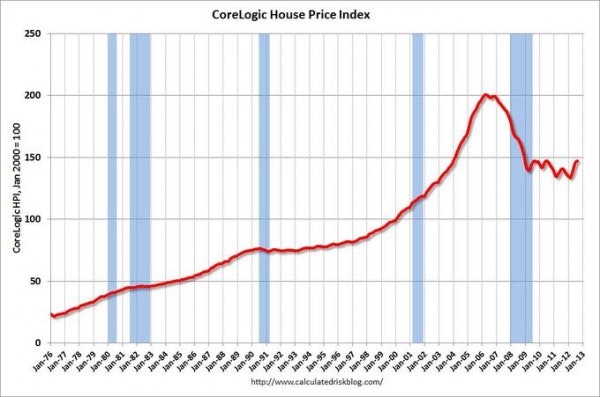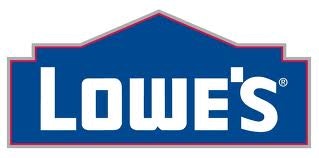A SWOT analysis is a look at a company’s strengths, weaknesses, opportunities, and threats, and is a tremendous way to gain a detailed and thorough perspective on a company and its future. As 2013 begins, I would like to focus on a leading home improvement retailer: Lowe’s Companies, Inc. (NYSE:LOW).
1). Solid Revenue Growth: In 2007, Lowe’s reported revenue of $46.93 billion; in 2012, the company announced revenue of $50.21 billion, representing year over year annual growth of 1.36%, a trend that is anticipated to accelerate into the future with projections placing 2017 revenue at $58.55 billion. This growth has been a result of the economic recovery in the United States and a revival of consumer and homebuilding spending
2). Institutional Vote of Confidence: 77% of shares outstanding are held by institutional investors, displaying the confidence some of the largest investors in the world have in the company and its future
3). Reasonable Valuation: At the moment, Lowe’s carries a price to earnings ratio of 22.95, a price to book ratio of 2.89, and a price to sales ratio of 0.86, all of which indicate a company trading with a fairly reasonable valuation when growth and future prospects are taken into account
4). Dividend: Currently, the company pays out quarterly dividends of $0.16, which when annualized puts the dividend as yielding 1.66%, an upside to the business
5). Historical Margin Expansion: Historically speaking, since 1980 Lowe’s gross profit has grown 11.79k%, while revenue has only grown 6.23k%, which represents margin expansion, an extremely beneficial aspect to the company
6). Strong Correlation with Accelerating Housing Market: Lowe’s sales growth is highly linked to the housing market, as a great portion of their revenue is derived from housing and building materials, and recently the housing market has accelerated in its recovery, which should greatly benefit Lowe’s

Weaknesses:
1). Net Debt: Despite possessing $1.66 billion of cash, cash equivalents, and short and long-term investments on their balance sheets, Lowe’s $14.5 billion debt load results in a net debt of $12.84 billion, a major downside to the business
2). Single Digit Margin: Because of the extremely competitive nature of Lowe’s industry, the company carries a net profit margin of 3.63%, which leaves very little room for any unexpected expenditures
3). Concentration in US: Lowe’s currently operates 1,745 stores, 1,712 of which are located in the United States, with 31 stores in Canada and 2 in Mexico, and this concentration in the United States could prove to be a weakness in any economic declines specific to the American economy
4). Extreme Cyclical Nature: Lowe’s success is incredibly correlated to overall economic activity, and in past recessions in the United States Lowe’s has greatly suffered. This extreme cyclical nature of their business could prove to be a weakness in economic downfalls
Opportunities:
1). Market Share: At the moment, Lowe’s possesses a 11.6% market share of the United States plumbing, electrical, and kitchen industry, a 35.8% market share of the hardware and seasonal industry, a 4.11% market share of the building materials, lumber, and millwork industry, and a 39.4% market share of the paint and flooring industry, and growth by the company in market share in any of these industries would undeniably benefit growth
2). Growth in Core Markets: Any growth in Lowe’s core markets would significantly help the company and spur growth
3). Geographical Expansion: 98.11% of Lowe’s total stores are located in the United States, leaving plenty of room for geographical expansion, which is widely anticipated to occur into the future, with industry analysts’ projections placing the number of international Lowe’s stores by 2019 at 115
4). Dividend Growth: Since implementing their dividend program in 1961 the company has consistently raised its dividend payouts, and should continue to do so into the future as revenue increases and the company currently only possesses a dividend payout ratio of 37.1%

Threats:
1). Competition: The industries Lowe’s operates in are extremely competitive, and the battle to offer the best product for the least amount of money can lead to margin contraction
2). Rising Input Prices: The prices of the products Lowe’s sells at its stores are consistently fluctuating, and any rising input prices could leave the company with the decision to raise prices on their customers or swallow the pain in their margins
Competition:
Major publicly traded competitors of Lowe’s include The Home Depot, Inc. (NYSE:HD), Lumber Liquidators Holdings Inc (NYSE:LL) , and Amazon.com, Inc. (NASDAQ:AMZN) . All of these companies operate in the same industries as Lowe’s and compete directly with the company. Both Home Depot and Lumber Liquidators offer similar to identical products at physical locations, while Amazon.com offers some these products on their website. Home Depot is valued at $100.63 billion, pays out a dividend yielding 1.72%, and carries a price to earnings ratio of 23.82. Lumber Liquidators is valued at $1.60 billion, does not pay out a dividend, and carries a price to earnings ratio of 39.71. Amazon is valued at $120.31 billion, does not pay out a dividend, and carries a negative price to earnings ratio.
The Foolish Bottom Line:
Financially, Lowe’s is a relatively solid company. The company possesses good revenue growth, a sizable dividend, and a strong correlation to the accelerating housing market. However, the company’s slim margin and relatively large debt load is troubling. Lowe’s future is filled to the brim with potential opportunities that could produce growth, but the company faces several threats. All in all, on any pullback from these all-time highs by the stock, Lowe’s is a great addition to any long-term portfolio, and should benefit significantly in the short-term due to the growth in the housing market.
The article Never Stop Improving, Never Stop Investing originally appeared on Fool.com and is written by Ryan Guenette.
Copyright © 1995 – 2013 The Motley Fool, LLC. All rights reserved. The Motley Fool has a disclosure policy.






